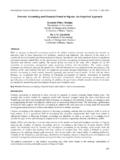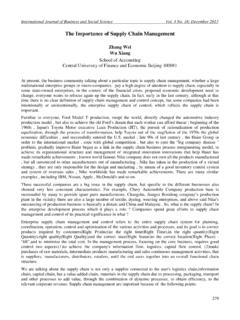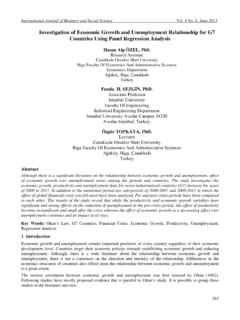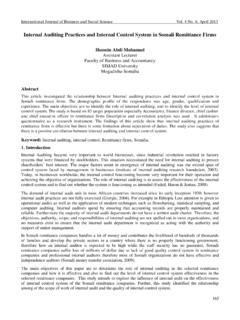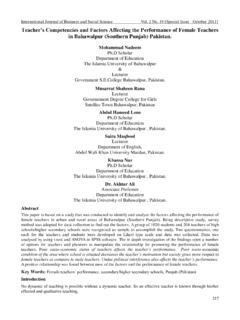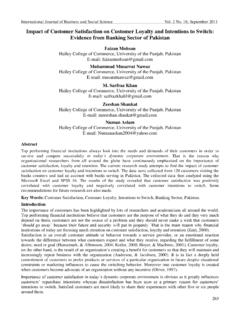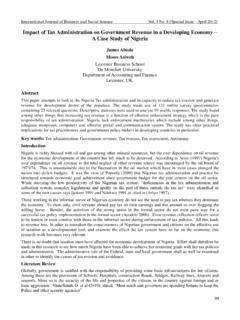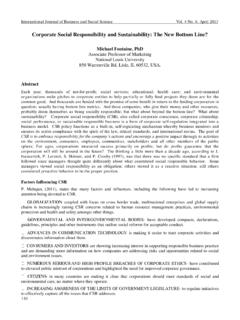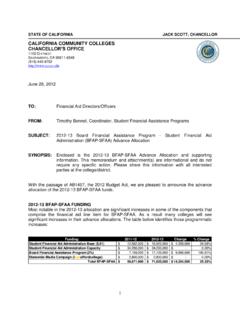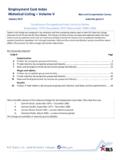Transcription of AN ECONOMETRIC ANALYSIS OF DETERMINANTS OF …
1 International Journal of Business and Social Science Vol. 3 No. 6; [Special Issue - march 2012]. AN ECONOMETRIC ANALYSIS OF DETERMINANTS OF EXCHANGE RATE IN. PAKISTAN. Ahmed Saeed Department of Business Administration University of Sargodha Pakistan Rehmat Ullah Awan Department of Economics University of Sargodha Pakistan Dr Maqbool H. Sial Department of Business Administration University of Sargodha Pakistan Falak Sher Department of Economics University of Sargodha Pakistan Abstract This study undertakes an ECONOMETRIC ANALYSIS of DETERMINANTS of exchange rate for US dollar in terms of Pakistani Rupee within the framework of monetary approach.
2 Monthly data from January 1982 to April 2010 for Pakistan relative to USA have been used to examine the long run and short run behavior of PKR/USD exchange rate and relationship of exchange rate behavior with relative monetary variables. Stock of money, foreign exchange reserves and total debt of Pakistan relative to United States along with Political instability in Pakistan as a dummy variable are taken as DETERMINANTS of PKR/USD exchange rate during the managed floating regime in Pakistan. ARDL approach to co-integration and error correction model are applied. Empirical results confirm that stock of money, debt and foreign exchange reserve balance all in relative terms are significant DETERMINANTS of exchange rate between Pakistani Rupee and US dollar .
3 Moreover, Political instability has a significant negative effect on the value of domestic currency. Keywords: Exchange Rate, Stock of Money, Foreign Exchange Reserve Balance, Debt, Monetary Approach, Co-integration, Error Correction Model, ARDL. Introduction Modeling of exchange rate behavior is one of the unsolved issues of research to be dealt with. Due to the enormous significance of the exchange rate in an economy, no one can deny the need to understand the behavior of foreign exchange markets. There is a need to study exchange rate DETERMINANTS and behavior of foreign exchange markets in detail.
4 Monetary approach developed in 1970's is one important tool to explain variation in the exchange rate. Some questions require answers like: what should be equilibrium exchange rate? How is it determined? What are the DETERMINANTS of exchange rate? Estimation and prediction of foreign exchange rate poses substantial theoretical and experimental challenge. Changes in exchange rate have pervasive effects, with consequences for prices, wages, interest rates, production levels, and employment opportunities. Fluctuations in the value of currencies of different economies have increased after the collapse of Bretton Woods System.
5 Especially short term variability has dramatically increased following the shift from fixed to flexible exchange rate in early 1970's and there after. High volatility and sudden changes in exchange rate is one of the hurdles for the success of macroeconomic policy. A model with theoretical and empirical validity needs to be developed. Forecasting nominal exchange rates is a difficult task especially in a flexible exchange rate arrangement (Rogoff, 2009). 184. The Special Issue on Contemporary Research in Business and Economics Centre for Promoting Ideas, USA. Factors affecting exchange rate can be economic, political, psychological and also the short run or long run.
6 Behavior of exchange rate may be more appropriately studied through macro variables and/ or micro variables. Policy makers would like to know what can be feasibly done to limit the fluctuation in the values of the currencies. What forces are involved in the fluctuations of currency values? How can the behavior of exchange rate be estimated and predicted? To find the answers to these policy issues, economists have engaged in extensive conceptual and empirical research aimed at explaining the behavior of exchange rates since early 1970's. So far research efforts made by the researchers to understand the behavior of exchange rate have met with only limited success.
7 Meanwhile policy guidelines have been evolved and lessons have been learnt from, but raised new questions by the experience of attempting to maintain macroeconomic stability in an evolving world economy. There are two main schools of thought of fundamentalists addressing the issue of exchange rate determination and forecasting. One school of thought is of the view that it is the demand for and supply of currencies with flow concept that determines the equilibrium value of currencies. They use balance of payment information to determine the demand and supply of currencies. Whereas the other school of thought is of the view that equilibrium value of relative stock of financial assets determines the behavior of exchange rate.
8 It is the ratio of financial assets of the respective country which determines the equilibrium exchange rate. Changes in the stock of financial assets are source of fluctuation in the values of exchange rate. It can be inferred from the various approaches/models and discussions in prior studies, that the behavior of exchange rate is a complex issue having many dimensions. Research work based on balance of payment approach rests mainly on elasticity approach or absorption approach. Whereas research based on monetary approach uses purchasing power parity condition, Quantity theory of money (QTM), Interest rates parity, money demand function and cumulative current account position to examine the exchange rate behavior.
9 In the early 1980's, it appeared certain that empirical research has not founded support in favor of monetary approach to exchange rate. However, due to the advancement in the ECONOMETRIC techniques, statistical tools and model specifications, recent empirical research has provided supportive evidence for the long run validity of monetary approach (Wilson, 2009). This study has been organized as follows; Section 2 presents a brief history of Exchange rate system for Pak Rupee. Detailed summary of various theoretical and empirical research is given in section 3. Section 4 describes data and methodology used for empirical estimations of the factors affecting foreign exchange rates in Pakistan.
10 The results of the empirical estimations are presented and discussed in section 5. Section 6 concludes the study with policy recommendations and implications for further research. 2. Brief History of Exchange Rate System for Pakistani Rupee: Before 1971, Pakistani Rupee was linked with Pound Sterling. In 1971, Pakistan decided to de-link Rupee from Pound and pegged it with US dollar . In 1982, Pakistan moved towards managed floating exchange rate mechanism because it was believed by the policy makers that Rupee pegged rate with US dollar was significantly shifted away from the fundamentals. Rupee was allowed to float on the basis of trade weighted basket of currencies.
